

It's a new quarter. This means it's time for a new release of this TechBytes newsletter to you, avid Catalyst users.
Really exciting news, Catalyst 11 as arrived!
Just in time for the end of year holiday season, like a new toy from Santa, Catalyst 11 shipped. The 32 and 64bit installers were uploaded to our website, ready for download. Full with new features including a new Ribbon interface, many of you have shared my excitement and upgraded within days.
Catalyst 11 is packed with new features: the user experience is improved, there are new file format support, some of the Experts are enhanced, the installers have been improved and so much more... But what I really want to highlight is that many of the new and improved features in this release are the direct result of your feedback. For example, exporting to XLIFF was a functionality many of you requested. So we added it!
Also, remember that all the released TechBytes articles are available on our website, in the Support section. Use your Support Centre login to access all the past articles along with other resources available to our premium support members.
As always, don't hesitate to let me know if there is any topic you would like covered in this TechBytes newsletter.
Cyril Vallin
Product Support Manager at Alchemy Software Development.
Catalyst 11 released
In December 2014, the latest version of your favourite localisation tool released!
I am really excited with this release as it is packed with new and enhanced features, including a new interface with Ribbons.
Review the new features on our website: https://www.alchemysoftware.com/products/alchemy_catalyst.html > Click What's New tab.
We have had a series of great Webinars on the new features of Catalyst 11. They were very successful and the team was delighted to present to so many of you. If you didn't get a chance to attend one of the meetings and you are very interested to find out more on all that's new in this release, don't hesitate to contact us.
Or check this video recording of one of the What's New in CATALYST 11 webinar.
Watch this procedural video which shows how to Download, Install and setup a Translator/Lite license for Catalyst 11.
Watch this video to quickly learn to translate Alchemy Catalyst 11 translation projects. Although the video is created using a Translator/Lite free license, it is also an excellent starter material for Translator/Pro new users.
Catpack (Catalyst translation package)
Catpack is a new Expert giving you the ability to dispatch your translation projects to translators. Catpack is a new Alchemy file extension (.catpack) short for Catalyst translation package, which contains all the resources needed for your translators. The feature is only available in the Developer/Pro edition of Catalyst 11.
Found in the Expert ribbon, click on Create Package to bundle a catpack.

A catpack is an easy medium for dispatching all the relevant files and information to another Catalyst user. In most cases a Translator. All editions can open this bundle, including Translator/Lite users. A Catpack can include:
- Project TTK files
- Translation Memory files
- Glossary files
- Instructions relevant to this catpack bundle
The first 3 tabs allow to add project specific files.
You can add as many TTK project files you need in the first tab. Those projects are treated as "to be translated".
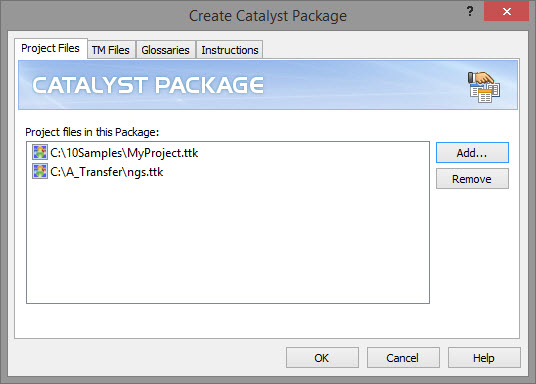
The TM Files tab allows to attach any Translation Memory reference which is applicable for the project. All formats supported by Catalyst as TM can be added.
The Glossaries tab works just like the TM Files tab. Allowing to add any Glossary files, in any format supported by Catalyst, which should be adhered to in the project's translations.
Finally, the Instructions tab give an opportunity to add notes or instructions on the project. Why not the deadline too!
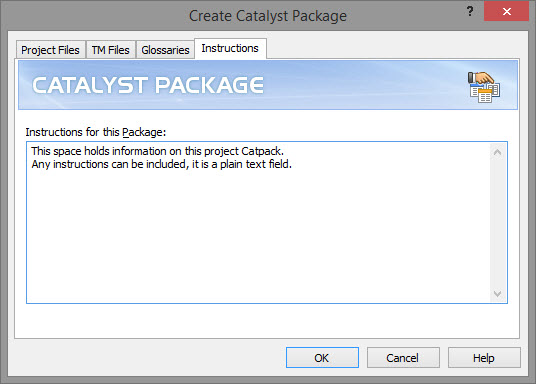
When you click the OK button, you are prompted to specify the filename for the catpack and the location to save.
This filename.catpack file can then be sent to the intended recipient, who can just open it by either double clicking the file in Windows File Explorer, or using the FILE > Open Project... option in Catalyst. Select the Catalyst Package (*.catpack) file format in the Open dialog.
Opening a catpack
When opening a catpack with either of the methods described above, the catpack dialog opens with the instructions displayed as the first tab.
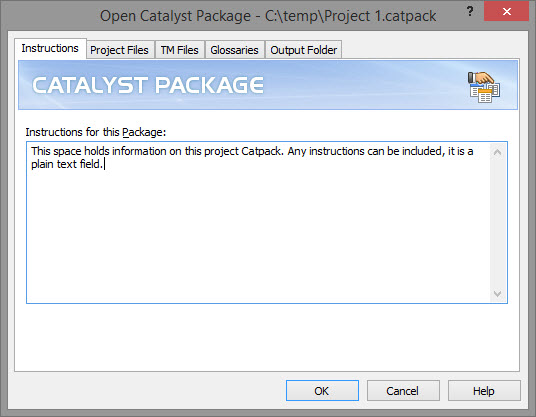
On the Project Files tab, the user can review the list of TTK project files included. The tick box gives the option to omit files from being extracted in the output.
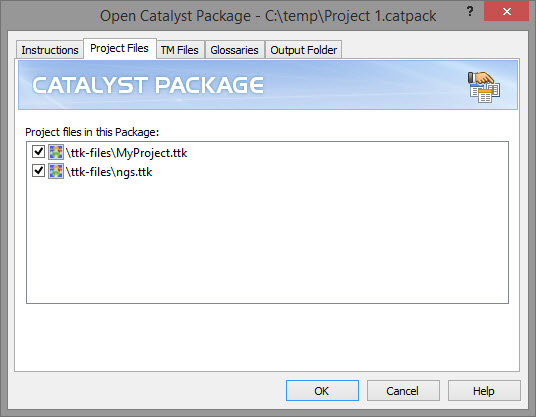
Similarly, files can be deselected in the TM Files and Glossaries tabs.
The top section lists the files included in the catpack, while the lower section lists the current active TMs in your installation of Catalyst.
Unticking TM files currently active in Catalyst will render them inactive (as if you unticked them in the Translator Toolbar) but will not remove them from the list of Active TMs.
The ticked TM files in this package will be added to the user's Active TMs list as well as being included in the output of the catpack.
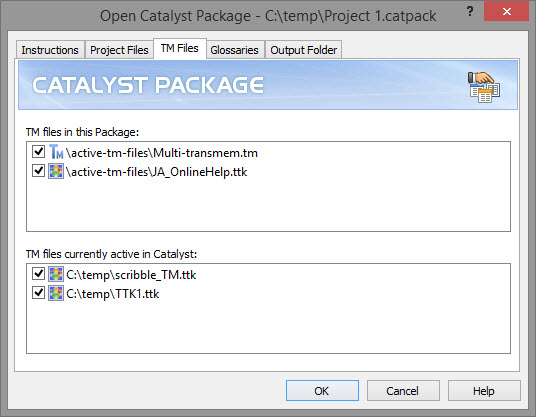
The same principals apply to the Glossaries.
The top section lists the glossaries in the catpack and the lower section lists the glossaries currently attached in the user's Catalyst.
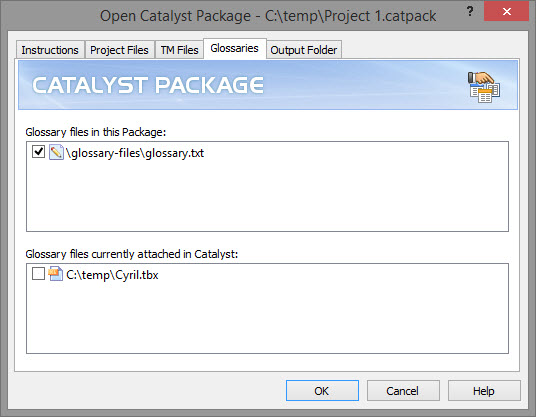
Finally, when all files have been selected or deselected, the Output Folder tab defines the location on the user's harddisk to "output", or extract, the selected contents.
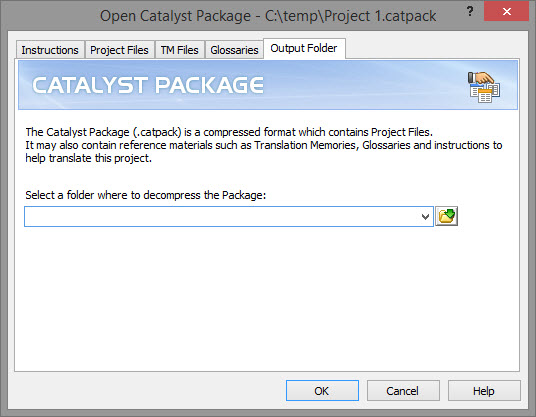
A .catpack file is a compressed file containing all the elements needed to complete a translation step. It is an ideal feature to deliver not only the .ttk files for translation but also the needed references (TM and glossaries) without the recipient needing to know where or which files to use. Since they are automatically attached in Catalyst on opening the catpack.
This is particularly effective with new users of Catalyst (often Translator/Lite users)
as they don't need to know how to configure their environment to get started with translating the project.
What better way to compliment the new addition of Ribbons in the interface of Catalyst 11 than adding parsing rules for Ribbon resources. The newfile format supported is .mfcribbon-ms, defined in the parsing rules under the XML file group.
No specific configuration is needed to insert files including Ribbons resources or .mfcribbon-ms files directly. Here is an example using the Catalyst executable itself.
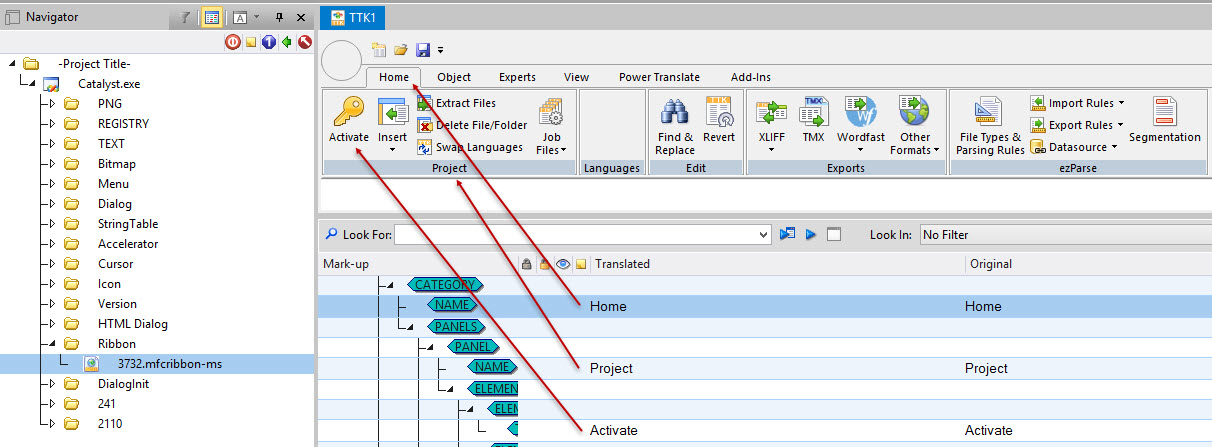
There are different means to produce Ribbons in your application, but not all of them are supported by Catalyst's Visual View.
There are 2 ways to add a ribbon to a Windows program:
1) Adding an xml file to the resources which contains all the strings and buttons info which appear in the Ribbon.
2) Create the ribbon class dynamically, in code, and store all the localizable data in string table and image resources.
Catalyst has a special handling for the first case (1), creating Visual View for the Ribbon from the ribbon xml file.
Unfortunately, Catalyst cannot generate a visual view for the second case (2). In that case the localizable strings used in the ribbon will appear among the rest of the resources in String Tables or wherever they are included in the resource files.
There is actually a third way (3). Using a mix of 1) and 2), developers can have a basic xml file with most of the ribbon structure and resources, however it is modified that at runtime, with code.
A per case (2), Catalyst can only render a Visual View for the resources found in the xml file.
The following page, by Microsoft, explains how to convert an CMFCRibbonBar object to an a xml file. Allowing you to localise your application's Ribbons in Catalyst with Visual View:
https://msdn.microsoft.com/en-us/library/ee354411.aspx
Thanks for taking the time to read this instalment of TechBytes. It has been fun to write and I hope you found some if not all of it beneficial. We always welcome new article ideas, so if there is a feature you feel works really well and is worth mentioning, or indeed if clarification on a particular topic would help you, please let me know so together we can make TechBytes as useful as possible for everyone.
My best wishes
Cyril Vallin
![]()